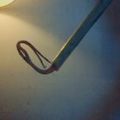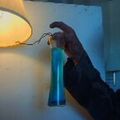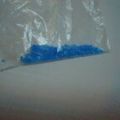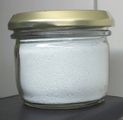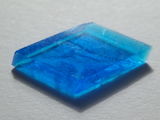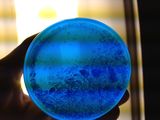Difference between revisions of "Copper(II) sulfate"
(→Gallery) |
|||
| (10 intermediate revisions by 2 users not shown) | |||
| Line 1: | Line 1: | ||
| − | + | {{Chembox | |
| − | [[ | + | | Name = Copper(II) sulfate |
| + | | Reference = | ||
| + | | IUPACName = Copper(II) sulfate | ||
| + | | PIN = | ||
| + | | SystematicName = | ||
| + | | OtherNames = Blue vitriol (pentahydrate)<br>Bluestone (pentahydrate)<br>Bonattite (trihydrate mineral)<br>Boothite (heptahydrate mineral)<br>Chalcanthite (pentahydrate mineral)<br>Chalcocyanite (mineral)<br>Cupric sulfate | ||
| + | <!-- Images --> | ||
| + | | ImageFile = Copper(II)_sulfate_pentahydrate.jpg | ||
| + | | ImageSize = 300 | ||
| + | | ImageAlt = | ||
| + | | ImageName = | ||
| + | | ImageCaption = Copper(II) sulfate pentahydrate crystal | ||
| + | | ImageFile1 = | ||
| + | | ImageSize1 = | ||
| + | | ImageAlt1 = | ||
| + | | ImageName1 = | ||
| + | | ImageFile2 = | ||
| + | | ImageSize2 = | ||
| + | | ImageAlt2 = | ||
| + | | ImageName2 = | ||
| + | | ImageFile3 = | ||
| + | | ImageSize3 = | ||
| + | | ImageAlt3 = | ||
| + | | ImageName3 = | ||
| + | | ImageFileL1 = | ||
| + | | ImageSizeL1 = | ||
| + | | ImageAltL1 = | ||
| + | | ImageNameL1 = | ||
| + | | ImageFileR1 = | ||
| + | | ImageSizeR1 = | ||
| + | | ImageAltR1 = | ||
| + | | ImageNameR1 = | ||
| + | | ImageFileL2 = | ||
| + | | ImageSizeL2 = | ||
| + | | ImageAltL2 = | ||
| + | | ImageNameL2 = | ||
| + | | ImageFileR2 = | ||
| + | | ImageSizeR2 = | ||
| + | | ImageAltR2 = | ||
| + | | ImageNameR2 = | ||
| + | <!-- Sections --> | ||
| + | | Section1 = {{Chembox Identifiers | ||
| + | | 3DMet = | ||
| + | | Abbreviations = | ||
| + | | SMILES = | ||
| + | }} | ||
| + | | Section2 = {{Chembox Properties | ||
| + | | AtmosphericOHRateConstant = | ||
| + | | Appearance = White solid (anhydrous)<br>Blue solid (pentahydrate) | ||
| + | | BoilingPt = | ||
| + | | BoilingPtC = | ||
| + | | BoilingPt_ref = | ||
| + | | BoilingPt_notes = Decomposes | ||
| + | | Density = 3.60 g/cm<sup>3</sup> (anhydrous)<br> 2.286 g/cm<sup>3</sup> (pentahydrate) | ||
| + | | Formula = CuSO<sub>4</sub> (anhydrous)<br>CuSO<sub>4</sub>·5H<sub>2</sub>O (pentahydrate) | ||
| + | | HenryConstant = | ||
| + | | LogP = | ||
| + | | MolarMass = 159.609 g/mol (anhydrous)<br>249.685 g/mol (pentahydrate) | ||
| + | | MeltingPt = | ||
| + | | MeltingPtC = | ||
| + | | MeltingPt_ref = | ||
| + | | MeltingPt_notes = ''anhydrous''<br>650 °C (1,202 °F; 923 K) (decomposition)<hr>''pentahydrate''<br>110 °C (230 °F; 383 K) (decomposition) | ||
| + | | Odor = Odorless | ||
| + | | pKa = | ||
| + | | pKb = | ||
| + | | Solubility = ''anhydrous''<br>14.3 g/100 ml (0 °C)<br>17.2 g/100 ml (10 °C)<br>20.5 g/100 ml (20 °C)<br>22.3 g/100 ml (25 °C)<br>24.4 g/100 ml (30 °C)<br>28.7 g/100 ml (40 °C)<br>33.7 g/100 ml (50 °C)<br>39.5 g/100 ml (60 °C)<br>55.5 g/100 ml (80 °C)<br>75.4 g/100 ml (100 °C)<hr>''pentahydrate''<br>23.1 g/100 ml (0 °C)<br>27.5 g/100 ml (10 °C)<br>32 g/100 ml (20 °C)<br>37.8 g/100 ml (30 °C)<br>44.6 g/100 ml (40 °C)<br>61.8 g/100 ml (60 °C)<br>83.8 g/100 ml (80 °C)<br>114 g/100 ml (100 °C) | ||
| + | | SolubleOther = ''Anhydrous''<br>Insoluble in [[ethanol]]<hr>''Pentahydrate''<br>Insoluble in [[acetone]], [[ethanol]] | ||
| + | | Solubility1 = ''pentahydrate''<br>1.04 g/100 ml (18 °C) | ||
| + | | Solvent1 = methanol | ||
| + | | VaporPressure = ~0 mmHg | ||
| + | }} | ||
| + | | Section3 = {{Chembox Structure | ||
| + | | Coordination = | ||
| + | | CrystalStruct = Orthorhombic (anhydrous, chalcocyanite), space group Pnma, oP24, a = 0.839 nm, b = 0.669 nm, c = 0.483 nm.[5] | ||
| + | Triclinic (pentahydrate), space group P1, aP22, a = 0.5986 nm, b = 0.6141 nm, c = 1.0736 nm, α = 77.333°, β = 82.267°, γ = 72.567° | ||
| + | | MolShape = | ||
| + | }} | ||
| + | | Section4 = {{Chembox Thermochemistry | ||
| + | | DeltaGf = | ||
| + | | DeltaHc = | ||
| + | | DeltaHf = −769.98 kJ/mol | ||
| + | | Entropy = 5 J ·mol<sup>−1</sup>·K<sup>−1</sup> | ||
| + | | HeatCapacity = | ||
| + | }} | ||
| + | | Section5 = {{Chembox Explosive | ||
| + | | ShockSens = | ||
| + | | FrictionSens = | ||
| + | | DetonationV = | ||
| + | | REFactor = | ||
| + | }} | ||
| + | | Section6 = {{Chembox Hazards | ||
| + | | AutoignitionPt = Non-flammable | ||
| + | | ExploLimits = Non-explosive | ||
| + | | ExternalMSDS = [https://www.docdroid.net/0FgmzJt/copperii-sulfate-anhydrous-sa.pdf.html Sigma-Aldrich] (anhydrous)<br>[https://www.docdroid.net/1saKdLe/copperii-sulfate-pentahydrate-sa.pdf.html Sigma-Aldrich] (pentahydrate) | ||
| + | | FlashPt = Non-flammable | ||
| + | | LD50 = 300 mg/kg (rat, oral) | ||
| + | | LC50 = | ||
| + | | MainHazards = Irritant | ||
| + | | NFPA-F = | ||
| + | | NFPA-H = | ||
| + | | NFPA-R = | ||
| + | | NFPA-S = | ||
| + | }} | ||
| + | | Section7 = {{Chembox Related | ||
| + | | OtherAnions = | ||
| + | | OtherCations = | ||
| + | | OtherFunction = | ||
| + | | OtherFunction_label = | ||
| + | | OtherCompounds = [[Copper(I) sulfate]]<br>[[Zinc sulfate]] | ||
| + | }} | ||
| + | }} | ||
'''Copper(II) sulfate''', also known as '''cupric sulfate''', '''copper sulphate''' or archaically '''blue vitriol''' or '''vitriol of Cyprus''', is the [[chemical compound]] with the [[chemical formula]] CuSO<sub>4</sub>. This [[salt]] exists as a series of compounds that differ in their degree of [[Hydrate|hydration]]. The anhydrous form is a pale green or gray-white powder, whereas the pentahydrate (CuSO<sub>4</sub>·5H<sub>2</sub>O), the most commonly encountered salt, is bright blue and forms triclinic crystals. Copper(II) sulfate [[Exothermic reaction|exothermically]] dissolves in water to give the aquo complex [Cu(H<sub>2</sub>O)<sub>6</sub>]<sup>2+</sup>, which has octahedral molecular geometry and is [[Paramagnetism|paramagnetic]]. Copper sulfate pentahydrate occurs in nature as mineral '''chalcantite'''. | '''Copper(II) sulfate''', also known as '''cupric sulfate''', '''copper sulphate''' or archaically '''blue vitriol''' or '''vitriol of Cyprus''', is the [[chemical compound]] with the [[chemical formula]] CuSO<sub>4</sub>. This [[salt]] exists as a series of compounds that differ in their degree of [[Hydrate|hydration]]. The anhydrous form is a pale green or gray-white powder, whereas the pentahydrate (CuSO<sub>4</sub>·5H<sub>2</sub>O), the most commonly encountered salt, is bright blue and forms triclinic crystals. Copper(II) sulfate [[Exothermic reaction|exothermically]] dissolves in water to give the aquo complex [Cu(H<sub>2</sub>O)<sub>6</sub>]<sup>2+</sup>, which has octahedral molecular geometry and is [[Paramagnetism|paramagnetic]]. Copper sulfate pentahydrate occurs in nature as mineral '''chalcantite'''. | ||
==Properties== | ==Properties== | ||
===Physical properties=== | ===Physical properties=== | ||
| − | Copper(II) sulfate is a blue crystalline solid as the pentahydrate, as it is most commonly seen, and the anhydrous form is a white to light gray powder. It has a solubility of 31.6 g/ | + | Copper(II) sulfate is a blue crystalline solid as the pentahydrate, as it is most commonly seen, and the anhydrous form is a white to light gray powder. It has a solubility of 31.6 g/100 mL at 0˚C and 203.3 g/100 mL at 100˚C. Dissolution is slow yet exothermic, and solutions of copper(II) sulfate are dark blue. |
===Chemical properties=== | ===Chemical properties=== | ||
| − | Copper(II) sulfate is most commonly encountered as the blue pentahydrate, but it can be dehydrated at 200˚C to form the white, powdery, anhydrous variant. At 650˚C, it will [[Thermal decomposition|decompose]] to form [[copper(II) oxide]] and [[sulfur trioxide]]. It emits an emerald green color in a [[flame test]]. The copper(II) ions in solution can complex with ammonia to form [[tetraamminecopper(II) sulfate]], which may be crystallized. Copper sulfate dissolves in concentrated [[ | + | Copper(II) sulfate is most commonly encountered as the blue pentahydrate, but it can be dehydrated at 200˚C to form the white, powdery, anhydrous variant. At 650˚C, it will [[Thermal decomposition|decompose]] to form [[copper(II) oxide]] and [[sulfur trioxide]]. It emits an emerald green color in a [[flame test]]. The copper(II) ions in solution can complex with ammonia to form [[tetraamminecopper(II) sulfate]], which may be crystallized. Copper sulfate dissolves in concentrated [[hydrochloric acid]] to form a bright green solution of [[tetrachlorocupric acid]]. This color turns to blue when diluted. |
| − | Metals more reactive than copper will react with copper(II) sulfate, leaving the [[sulfate]] salt of the metal and [[copper]]. Example, using zinc: | + | Metals more reactive than copper will react with copper(II) sulfate, leaving the [[sulfate]] salt of the metal and [[copper]]. Example, using [[zinc]] metal: |
| − | :CuSO<sub>4</sub> + Zn → ZnSO<sub>4</sub> + Cu | + | : CuSO<sub>4</sub> + Zn → ZnSO<sub>4</sub> + Cu |
The solid obtained can be treated with [[hydrochloric acid]] to get rid of excess zinc and other impurities. | The solid obtained can be treated with [[hydrochloric acid]] to get rid of excess zinc and other impurities. | ||
==Availability== | ==Availability== | ||
| − | + | Copper(II) sulfate can be found at most hardware stores as root killer for use in septic systems. These products are usually fairly pure, but require [[recrystallization]] to ensure their purity. This source, however, is suitable for use in crystal growing. It can be made from copper metal, nitric acid or [[hydrogen peroxide]], and concentrated [[sulfuric acid]], but this method is economically impractical if not used on an industrial scale. | |
| − | Copper(II) sulfate can be found at most hardware stores as root killer for use in septic systems. These products are usually fairly pure, but require [[recrystallization]] to ensure their purity. This source, however, is suitable for use in crystal growing. It can be made from copper metal, nitric acid or hydrogen peroxide, and concentrated [[sulfuric acid]], but this method is economically impractical if not used on an industrial scale. | + | |
==Preparation== | ==Preparation== | ||
Copper(II) sulfate can also be produced by the electrolysis of sulfuric acid with a copper anode and cathode. The cathode needs to be shielded at the top and exposed at the bottom of the solution. The anode should reside at the very top. The copper(II) sulfate will form a beautiful dark blue layer at the bottom. The solution should be decanted and crystallized. | Copper(II) sulfate can also be produced by the electrolysis of sulfuric acid with a copper anode and cathode. The cathode needs to be shielded at the top and exposed at the bottom of the solution. The anode should reside at the very top. The copper(II) sulfate will form a beautiful dark blue layer at the bottom. The solution should be decanted and crystallized. | ||
| + | |||
| + | A simpler route involves reacting copper "rust", like oxide, hydroxide or carbonate with sulfuric acid. Keep adding copper oxide until all the acid has been consumed, filter the solution then recrystallize the compound from the solution. | ||
| + | |||
| + | Likewise, bubbling [[sulfur dioxide]] in an aqueous suspension of copper oxide or copper hydroxide will give copper sulfite, which will oxidize in air to copper sulfate. | ||
==Projects== | ==Projects== | ||
| − | |||
*Growing crystals | *Growing crystals | ||
*Making copper metal | *Making copper metal | ||
| Line 44: | Line 156: | ||
==Gallery== | ==Gallery== | ||
| − | <gallery widths=" | + | <gallery widths="220" position="center" columns="4" orientation="none"> |
2014-06-19-092211.jpg|Shielded copper cathode | 2014-06-19-092211.jpg|Shielded copper cathode | ||
2014-06-19-094842.jpg|Electrolytic cell for producing copper(II) sulfate | 2014-06-19-094842.jpg|Electrolytic cell for producing copper(II) sulfate | ||
2014-06-19-095752.jpg|Copper(II) sulfate product, electrolytically produced | 2014-06-19-095752.jpg|Copper(II) sulfate product, electrolytically produced | ||
| + | C0146956-Anhydrous copper II sulphate-SPL.jpg|Anhydrous copper sulfate | ||
| + | Copper sulfate.jpg|Crystal showing the structure of the pentahydrate | ||
| + | Copper sulfate beaker.jpg|Copper sulfate crystals made by the hydrogen peroxide/sulfuric acid method | ||
| + | Copper(II)_sulfate_solution.jpg|A boiling solution of copper(II) sulfate prior to recrystallization | ||
</gallery> | </gallery> | ||
| Line 58: | Line 174: | ||
*CRC Handbook of Chemistry and Physics 66th Edition (1985-1986) | *CRC Handbook of Chemistry and Physics 66th Edition (1985-1986) | ||
*Personal electrolytic manufacture by Arkoma | *Personal electrolytic manufacture by Arkoma | ||
| + | |||
===Relevant Sciencemadness threads=== | ===Relevant Sciencemadness threads=== | ||
*[http://www.sciencemadness.org/talk/viewthread.php?tid=60907 Copper Sulfate and Potassium Chloride] | *[http://www.sciencemadness.org/talk/viewthread.php?tid=60907 Copper Sulfate and Potassium Chloride] | ||
| Line 68: | Line 185: | ||
[[Category:Easily prepared chemicals]] | [[Category:Easily prepared chemicals]] | ||
[[Category:Readily available chemicals]] | [[Category:Readily available chemicals]] | ||
| + | [[Category:Essential reagents]] | ||
[[Category:Minerals]] | [[Category:Minerals]] | ||
Latest revision as of 22:07, 26 August 2023
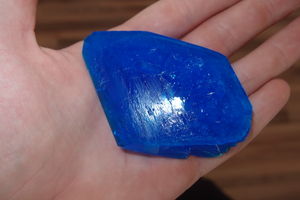 Copper(II) sulfate pentahydrate crystal
| |
| Names | |
|---|---|
| IUPAC name
Copper(II) sulfate
| |
| Other names
Blue vitriol (pentahydrate)
Bluestone (pentahydrate) Bonattite (trihydrate mineral) Boothite (heptahydrate mineral) Chalcanthite (pentahydrate mineral) Chalcocyanite (mineral) Cupric sulfate | |
| Properties | |
| CuSO4 (anhydrous) CuSO4·5H2O (pentahydrate) | |
| Molar mass | 159.609 g/mol (anhydrous) 249.685 g/mol (pentahydrate) |
| Appearance | White solid (anhydrous) Blue solid (pentahydrate) |
| Odor | Odorless |
| Density | 3.60 g/cm3 (anhydrous) 2.286 g/cm3 (pentahydrate) |
| Melting point | anhydrous 650 °C (1,202 °F; 923 K) (decomposition) pentahydrate 110 °C (230 °F; 383 K) (decomposition) |
| Boiling point | Decomposes |
| anhydrous 14.3 g/100 ml (0 °C) 17.2 g/100 ml (10 °C) 20.5 g/100 ml (20 °C) 22.3 g/100 ml (25 °C) 24.4 g/100 ml (30 °C) 28.7 g/100 ml (40 °C) 33.7 g/100 ml (50 °C) 39.5 g/100 ml (60 °C) 55.5 g/100 ml (80 °C) 75.4 g/100 ml (100 °C) pentahydrate 23.1 g/100 ml (0 °C) 27.5 g/100 ml (10 °C) 32 g/100 ml (20 °C) 37.8 g/100 ml (30 °C) 44.6 g/100 ml (40 °C) 61.8 g/100 ml (60 °C) 83.8 g/100 ml (80 °C) 114 g/100 ml (100 °C) | |
| Solubility | Anhydrous Insoluble in ethanol Pentahydrate Insoluble in acetone, ethanol |
| Solubility in methanol | pentahydrate 1.04 g/100 ml (18 °C) |
| Vapor pressure | ~0 mmHg |
| Thermochemistry | |
| Std molar
entropy (S |
5 J ·mol−1·K−1 |
| Std enthalpy of
formation (ΔfH |
−769.98 kJ/mol |
| Hazards | |
| Safety data sheet | Sigma-Aldrich (anhydrous) Sigma-Aldrich (pentahydrate) |
| Flash point | Non-flammable |
| Lethal dose or concentration (LD, LC): | |
| LD50 (Median dose)
|
300 mg/kg (rat, oral) |
| Related compounds | |
| Related compounds
|
Copper(I) sulfate Zinc sulfate |
| Except where otherwise noted, data are given for materials in their standard state (at 25 °C [77 °F], 100 kPa). | |
| Infobox references | |
Copper(II) sulfate, also known as cupric sulfate, copper sulphate or archaically blue vitriol or vitriol of Cyprus, is the chemical compound with the chemical formula CuSO4. This salt exists as a series of compounds that differ in their degree of hydration. The anhydrous form is a pale green or gray-white powder, whereas the pentahydrate (CuSO4·5H2O), the most commonly encountered salt, is bright blue and forms triclinic crystals. Copper(II) sulfate exothermically dissolves in water to give the aquo complex [Cu(H2O)6]2+, which has octahedral molecular geometry and is paramagnetic. Copper sulfate pentahydrate occurs in nature as mineral chalcantite.
Contents
Properties
Physical properties
Copper(II) sulfate is a blue crystalline solid as the pentahydrate, as it is most commonly seen, and the anhydrous form is a white to light gray powder. It has a solubility of 31.6 g/100 mL at 0˚C and 203.3 g/100 mL at 100˚C. Dissolution is slow yet exothermic, and solutions of copper(II) sulfate are dark blue.
Chemical properties
Copper(II) sulfate is most commonly encountered as the blue pentahydrate, but it can be dehydrated at 200˚C to form the white, powdery, anhydrous variant. At 650˚C, it will decompose to form copper(II) oxide and sulfur trioxide. It emits an emerald green color in a flame test. The copper(II) ions in solution can complex with ammonia to form tetraamminecopper(II) sulfate, which may be crystallized. Copper sulfate dissolves in concentrated hydrochloric acid to form a bright green solution of tetrachlorocupric acid. This color turns to blue when diluted.
Metals more reactive than copper will react with copper(II) sulfate, leaving the sulfate salt of the metal and copper. Example, using zinc metal:
- CuSO4 + Zn → ZnSO4 + Cu
The solid obtained can be treated with hydrochloric acid to get rid of excess zinc and other impurities.
Availability
Copper(II) sulfate can be found at most hardware stores as root killer for use in septic systems. These products are usually fairly pure, but require recrystallization to ensure their purity. This source, however, is suitable for use in crystal growing. It can be made from copper metal, nitric acid or hydrogen peroxide, and concentrated sulfuric acid, but this method is economically impractical if not used on an industrial scale.
Preparation
Copper(II) sulfate can also be produced by the electrolysis of sulfuric acid with a copper anode and cathode. The cathode needs to be shielded at the top and exposed at the bottom of the solution. The anode should reside at the very top. The copper(II) sulfate will form a beautiful dark blue layer at the bottom. The solution should be decanted and crystallized.
A simpler route involves reacting copper "rust", like oxide, hydroxide or carbonate with sulfuric acid. Keep adding copper oxide until all the acid has been consumed, filter the solution then recrystallize the compound from the solution.
Likewise, bubbling sulfur dioxide in an aqueous suspension of copper oxide or copper hydroxide will give copper sulfite, which will oxidize in air to copper sulfate.
Projects
- Growing crystals
- Making copper metal
- Making flash powder
- Make sulfuric acid
- Make sulfur trioxide
Handling
Safety
All copper salts, especially soluble ones, are moderately toxic. They should be stored out of reach of small children and pets. They are also toxic to the environment.
Storage
Copper sulfate hydrated can be stored in closed bottles. Anhydrous variety must be stored in sealed closed containers to prevent it from absorbing water from air.
Disposal
Copper sulfate can be disposed of by either precipitating it as the copper(II) carbonate, which is insoluble, and disposing of it as toxic waste.
Another good way is to reduce it with iron or zinc to elemental copper, that can be reused, while the resulting iron or zinc sulfate are much easier to dispose of, as they're less hazardous to the environment.
Gallery
See also
References
- http://en.wikipedia.org/wiki/Copper(II)_sulfate
- CRC Handbook of Chemistry and Physics 66th Edition (1985-1986)
- Personal electrolytic manufacture by Arkoma
